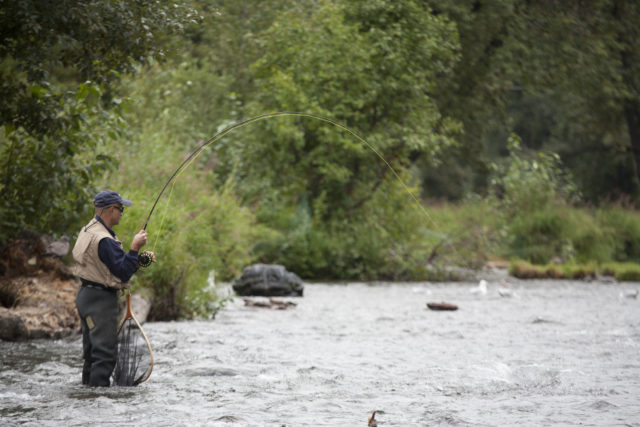Without a new five-year bill, conservation and voluntary access incentive programs are currently unavailable to well-intentioned landowners
On Sunday night at midnight, the 2014 Farm Bill expired, effectively hitting the pause button on a number of vital conservation programs. If Congress can’t get a new five-year bill reauthorized by the end of this Congress, it could have profound impacts on future funding for conservation programs and begin to influence whether farmers and ranchers across the nation even want to take advantage of conservation incentives.
“Farmers, ranchers, and forest owners across the country depend on Farm Bill conservation programs for the tools they need to protect and improve soil, water, and wildlife habitat on working lands, and this failure to pass an on-time Farm Bill means that farmers and ranchers will no longer be able to enroll in the full suite of conservation programs over the coming weeks,” says Aviva Glaser, director of agriculture policy at the National Wildlife Federation. “We call on Congress to come together quickly to pass a strong, bipartisan, and conservation-friendly Farm Bill.”
Until lawmakers resolve debate and vote to pass a new bill, well-intentioned landowners—whose demand for conservation programs already outstrips the funding available—can’t enroll in important programs and services that benefit wildlife, water quality, and outdoor recreation.
“Farmers, ranchers, and landowners need these conservation tools available to them to address natural resource concerns on their property,” says Jim Inglis, director of governmental affairs for Pheasants Forever and Quail Forever. “Right now, for example, enrollment in the Conservation Reserve Program—one of our country’s most successful conservation programs that provides tremendous benefits for wildlife while reducing soil erosion and improving water and air quality—is not possible. This means a loss of habitat benefits for pheasants, quail, and many other species across the country that we enjoy pursuing each fall.”
The lapse in authorization could also create confusion for hunters and anglers who rely on private land for access. “By missing the September 30 deadline, Congress has created tremendous uncertainty among sportsmen and women who enjoy the conservation and public-access benefits of the Voluntary Public Access and Habitat Incentive Program, a farm bill program that has opened hundreds of thousands of private acres for walk-in access to hunting and fishing,” says Alex Maggos, director of agriculture and private lands for the Theodore Roosevelt Conservation Partnership. “This could cause ripple effects in rural communities that typically see an influx of spending during the fall hunting season.”
Any bill that passes should contain strong conservation provisions and funding for key programs. “The Farm Bill plays a critical role in keeping America’s working lands in working hands and yields significant economic benefits to farms, ranches, and communities across our nation,” says Lori Faeth, government relations director of the Land Trust Alliance. “We urge Congress to pass a Farm Bill that restores funding for the Agricultural Conservation Easement Program to $500 million annually and enacts common-sense changes to make the Agricultural Land Easement program more efficient and effective. But Congress must act now. Every day we lack a new Farm Bill is another day we stand to lose another farm or ranch.”
“The expiration of the Farm Bill shuts the door on farmers, ranchers, and forest landowners trying to voluntarily protect and enhance their lands through the Regional Conservation Partnership Program,” says Jenny Conner Nelms, senior policy advisor for agriculture at The Nature Conservancy. “These innovative projects bring together public and private partners, who in the first five years have matched federal funding with more than $2 billion in local and private funding, to tackle local natural resource concerns and boost conservation nationwide. This popular program brings new partners to the table and has already funded projects from irrigation efficiency and soil health to base buffering around military installations—all of this will be on hold until Congress passes a new farm bill.”
“With nearly two-thirds of America’s forests under private ownership, mostly in the hands of families and individuals, the Farm Bill is a critical tool for forest conservation that benefits big game and upland birds,” says Brent Rudolph, director of conservation for the Ruffed Grouse Society and American Woodcock Society. “Improving stewardship of private and family-owned forests should be as bipartisan as any issue out there, especially considering that the Farm Bill is a resource for safeguarding clean air and water, providing incredible recreation and habitat value, and supporting more than 2.4 million rural jobs, as well. The inability to move a Farm Bill that provides such support is a missed opportunity and true disappointment.”







The Farm bill provided access to thousands that will never be able to afford private clubs.
It should be renewed.
Thanks Tim- I agree wholeheartedly. Please sign our letter to Congress and share with your friends. http://www.trcp.org/action-alert/farm-bill-2018/
The CRP is one of the few programs that brings money back into the economy. It provides
much needed funds that help each state with their conservation programs. Your help in passing this bill is also needed.
The Quail and Upland Game Alliance is concerned about the loss of CRP programs. In the next four years , over twelve million acres will expire from the past programs and as we understand there is no programs for these acres that are not in a floodplain to be reenrolled into. If this is not addressed, we will see a huge loss of upland habitat. Also not paying a competitive rental rate will cause a loss of these programs.
Jerry Johnson
Regional Director, Quail & Upland Game Alliance (QUGA)